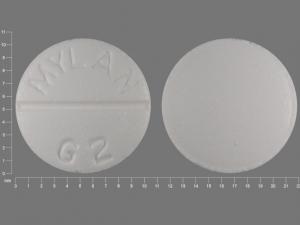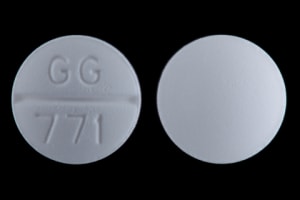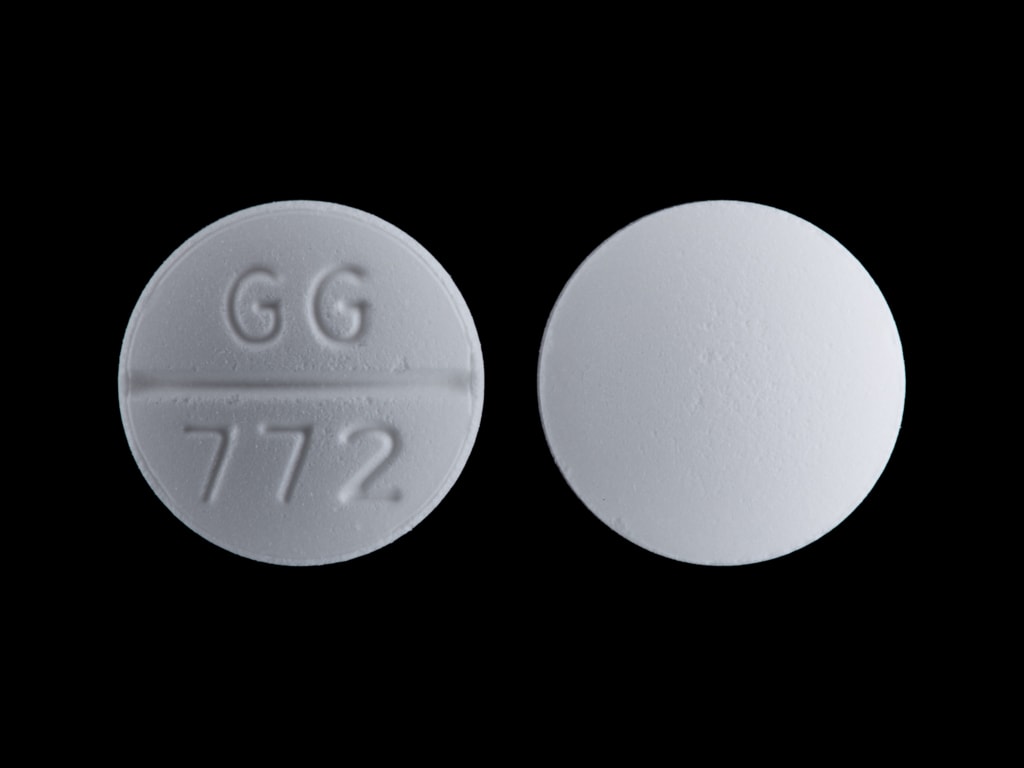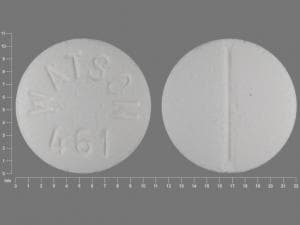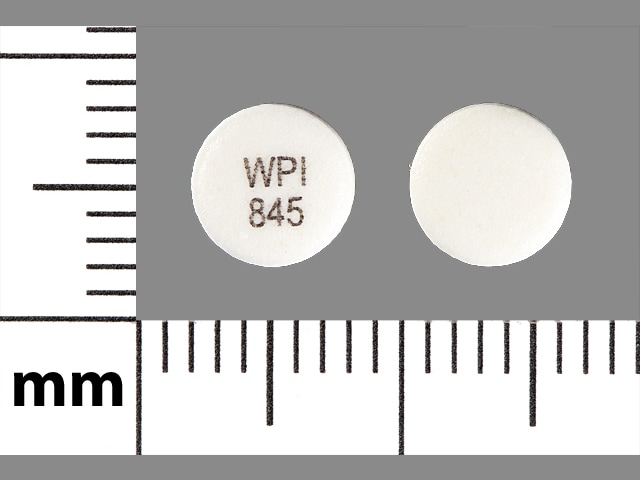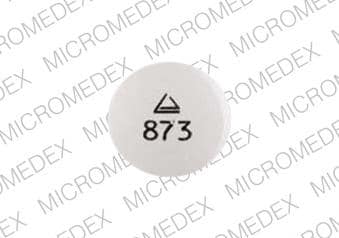Dosage Forms
Excipient information presented when available (limited, particularly for generics); consult specific product labeling.
Tablet, Oral:
Glucotrol: 5 mg, 10 mg [scored]
Generic: 5 mg, 10 mg
Tablet Extended Release 24 Hour, Oral:
glipiZIDE XL: 2.5 mg, 5 mg, 10 mg
Glucotrol XL: 2.5 mg, 5 mg, 10 mg
Generic: 2.5 mg, 5 mg, 10 mg
Pharmacology
Mechanism of Action
Stimulates insulin release from the pancreatic beta cells; reduces glucose output from the liver; insulin sensitivity is increased at peripheral target sites
Pharmacokinetics/Pharmacodynamics
Absorption
Immediate release: Rapid and complete; delayed with food
Distribution
10 to 11 L
Metabolism
Hepatic via CYP2C9; forms metabolites (inactive)
Excretion
Urine (<10% as unchanged drug; 80% as metabolites); feces (10%)
Time to Peak
1 to 3 hours; extended release tablets: 6 to 12 hours
Duration of Action
12 to 24 hours
Half-Life Elimination
2 to 5 hours
Protein Binding
98% to 99%; primarily to albumin
Use: Labeled Indications
Diabetes mellitus, type 2, treatment: Adjunct to diet and exercise to improve glycemic control in adults with type 2 diabetes mellitus
Contraindications
Hypersensitivity to glipizide, sulfonamide derivatives, or any component of the formulation; type 1 diabetes mellitus; diabetic ketoacidosis (with or without coma).
Note: Although glipizide extended-release (XL) FDA-approved product labeling states this medication is contraindicated with other sulfonamide-containing drug classes, the scientific basis of this statement has been challenged. See Warnings/Precautions for more detail.
Documentation of allergenic cross-reactivity for sulfonylureas is limited. However, because of similarities in chemical structure and/or pharmacologic actions, the possibility of cross-sensitivity cannot be ruled out with certainty.
Dosage and Administration
Dosing: Adult
Diabetes mellitus, type 2, treatment: Oral:
Note: Adjunctive or alternative monotherapy for patients who have suboptimal response to or cannot take metformin. Sulfonylureas are known to have a relatively high risk of hypoglycemia as compared to other noninsulin antidiabetic agents due to their mechanism of action (AACE [Garber 2019]; ADA 2019). In general, if a sulfonylurea is chosen, a shorter-duration sulfonylurea (eg, glipizide) is preferred (ADA 2019).
Immediate release:
Initial: 2.5 mg once daily (McCulloch 2019) administered 30 minutes before a meal (preferably before breakfast)
Titration: If adequate glycemic control is not obtained, may increase the dose in 2.5 to 5 mg increments no more frequently than every few days (manufacturer’s labeling); however, titration strategies are often more conservative in clinical practice. Most clinicians increase the dose more slowly at a frequency of every 1 to 2 weeks (DeFronzo 1999; Del Prato 2014) and some experts use a 2- to 4-week titration interval (McCulloch 2019). If a once-daily dose does not provide adequate glycemic control, dividing the daily dose into 2 doses, given 30 minutes before breakfast and 30 minutes before the evening meal, may improve efficacy; doses >15 mg/day should generally be administered in 2 divided doses.
Maximum effective dose: 20 mg/day (Abraira 1998; DeFronzo 1999; Wåhlin-Boll 1982). Note: Although a higher maximum total daily dose (40 mg/day) is listed in the manufacturer’s labeling, escalating the dose beyond 20 mg/day has not been shown to improve glycemic control (Abraira 1998; Hurren 2013; Stenman 1993; Wåhlin-Boll 1982).
Extended release:
Initial: 2.5 mg (McCulloch 2019) to 5 mg administered once daily with breakfast or the first meal of the day
Titration: Adjust dose based on glycemic control; one study allowed dosage increases in 5 to 10 mg increments once weekly (Berelowitz 1994)
Maximum dose: 20 mg/day
Patients already maintained on glipizide who require hospitalization: In patients who require hospitalization, consider temporary discontinuation of noninsulin antidiabetic agents (Bogun 2013; Inzucchi 2006) and initiation and/or continuation of insulin therapy (ADA 2019; Bogun 2013; Inzucchi 2006). Use of noninsulin antidiabetic agents may be considered in noncritically ill hospitalized patients if there are no contraindications, nutrition is consistent, and blood glucose is well controlled; close monitoring and subsequent dosage adjustments are recommended (Bogun 2013; Inzucchi 2006).
Glipizide conversion recommendations:
When converting from immediate-release glipizide to extended-release glipizide: May switch the immediate-release total daily dose to the nearest equivalent daily dose of the extended-release tablet and administer once daily.
When converting from insulin to immediate-release glipizide: Note: When determining the timing of the transition from insulin to glipizide, clinicians should consider the known onset and duration of the insulin product being discontinued; closely monitor blood glucose.
Current insulin requirement ≤20 units: Discontinue insulin and initiate glipizide at usual dose.
Current insulin requirement >20 units: Decrease insulin by 50% and initiate glipizide at usual dose; gradually decrease insulin dose based on patient response.
Dosing: Geriatric
Diabetes mellitus, type 2, treatment (alternative agent): Oral:
Note: For the treatment of type 2 diabetes in older adults, medication classes with low risk of hypoglycemia are preferred (ADA 2019); sulfonylureas are known to have a relatively high risk of hypoglycemia as compared to other noninsulin antidiabetic agents due to their mechanism of action (AACE [Garber 2019]; ADA 2019). In general, if a sulfonylurea is chosen, a shorter-duration sulfonylurea (eg, glipizide) is preferred (ADA 2019).
Immediate release: Initial: 2.5 mg once daily; consider titrating by 2.5 to 5 mg/day at 1- to 2-week intervals. Maintenance dosing should be conservative to avoid hypoglycemia.
Extended release: Initial: 2.5 mg once daily; maintenance dosing should be conservative to avoid hypoglycemia.
Administration
Oral: Note: Patients that are NPO or require decreased caloric intake may need doses held to avoid hypoglycemia.
Immediate release: Administer 30 minutes before a meal (preferably before breakfast if once-daily dosing) to achieve greatest reduction in postprandial hyperglycemia.
Extended release: Administer with breakfast or the first meal of the day; swallow tablets whole, do not chew, divide or crush.
Dietary Considerations
Take immediate release tablets 30 minutes before meals (preferably before breakfast if once-daily dosing); extended release tablets should be taken with breakfast or the first meal of the day. Individualized medical nutrition therapy (MNT) based on ADA recommendations is an integral part of therapy.
Storage
Extended release: Store at 68°F to 77°F (20°C to 25°C); excursions permitted between 59°F to 86°F (15°C to 30°C). Protect from moisture and humidity.
Immediate release: Store below 30°C (86°F).
GlipiZIDE Images
Drug Interactions
Ajmaline: Sulfonamides may enhance the adverse/toxic effect of Ajmaline. Specifically, the risk for cholestasis may be increased. Monitor therapy
Alcohol (Ethyl): Sulfonylureas may enhance the adverse/toxic effect of Alcohol (Ethyl). A flushing reaction may occur. Monitor therapy
Alpelisib: May decrease the serum concentration of CYP2C9 Substrates (High risk with Inducers). Monitor therapy
Alpha-Lipoic Acid: May enhance the hypoglycemic effect of Antidiabetic Agents. Monitor therapy
Aminolevulinic Acid (Systemic): Photosensitizing Agents may enhance the photosensitizing effect of Aminolevulinic Acid (Systemic). Avoid combination
Aminolevulinic Acid (Topical): Photosensitizing Agents may enhance the photosensitizing effect of Aminolevulinic Acid (Topical). Monitor therapy
Androgens: May enhance the hypoglycemic effect of Blood Glucose Lowering Agents. Exceptions: Danazol. Monitor therapy
Antidiabetic Agents: May enhance the hypoglycemic effect of Hypoglycemia-Associated Agents. Monitor therapy
Beta-Blockers: May enhance the hypoglycemic effect of Sulfonylureas. Cardioselective beta-blockers (eg, acebutolol, atenolol, metoprolol, and penbutolol) may be safer than nonselective beta-blockers. All beta-blockers appear to mask tachycardia as an initial symptom of hypoglycemia. Ophthalmic beta-blockers are probably associated with lower risk than systemic agents. Exceptions: Levobunolol; Metipranolol. Monitor therapy
Carbocisteine: Sulfonylureas may enhance the adverse/toxic effect of Carbocisteine. Specifically, sulfonylureas may enhance adverse effects of alcohol that is present in liquid formulations of carbocisteine-containing products. Monitor therapy
Chloramphenicol (Systemic): May decrease the metabolism of Sulfonylureas. Monitor therapy
Cimetidine: May increase the serum concentration of Sulfonylureas. Monitor therapy
Clarithromycin: May increase the serum concentration of GlipiZIDE. Monitor therapy
Colesevelam: May decrease the serum concentration of GlipiZIDE. Management: Administer glipizide at least 4 hours prior to colesevelam. Consider therapy modification
Cyclic Antidepressants: May enhance the hypoglycemic effect of Sulfonylureas. Monitor therapy
CYP2C9 Inhibitors (Moderate): May decrease the metabolism of CYP2C9 Substrates (High risk with Inhibitors). Monitor therapy
Dabrafenib: May decrease the serum concentration of CYP2C9 Substrates (High risk with Inducers). Management: Seek alternatives to the CYP2C9 substrate when possible. If concomitant therapy cannot be avoided, monitor clinical effects of the substrate closely (particularly therapeutic effects). Consider therapy modification
Dexketoprofen: May enhance the adverse/toxic effect of Sulfonamides. Monitor therapy
Dipeptidyl Peptidase-IV Inhibitors: May enhance the hypoglycemic effect of Sulfonylureas. Management: Consider a decrease in sulfonylurea dose when initiating therapy with a dipeptidyl peptidase-IV inhibitor and monitor patients for hypoglycemia. Consider therapy modification
Direct Acting Antiviral Agents (HCV): May enhance the hypoglycemic effect of Antidiabetic Agents. Monitor therapy
Elexacaftor, Tezacaftor, and Ivacaftor: May increase the serum concentration of GlipiZIDE. Monitor therapy
Enzalutamide: May decrease the serum concentration of CYP2C9 Substrates (High risk with Inducers). Management: Concurrent use of enzalutamide with CYP2C9 substrates that have a narrow therapeutic index should be avoided. Use of enzalutamide and any other CYP2C9 substrate should be performed with caution and close monitoring. Consider therapy modification
Fibric Acid Derivatives: May enhance the hypoglycemic effect of Sulfonylureas. Monitor therapy
Fluconazole: May increase the serum concentration of Sulfonylureas. Management: Seek alternatives when possible. If used together, monitor closely for increased effects of sulfonylureas if fluconazole is initiated/dose increased, or decreased effects if fluconazole is discontinued/dose decreased. Consider therapy modification
Glucagon-Like Peptide-1 Agonists: May enhance the hypoglycemic effect of Sulfonylureas. Management: Consider sulfonylurea dose reductions when used in combination with glucagon-like peptide-1 agonists. Consider therapy modification
Guanethidine: May enhance the hypoglycemic effect of Antidiabetic Agents. Monitor therapy
Herbs (Hypoglycemic Properties): May enhance the hypoglycemic effect of Hypoglycemia-Associated Agents. Monitor therapy
Hyperglycemia-Associated Agents: May diminish the therapeutic effect of Antidiabetic Agents. Monitor therapy
Hypoglycemia-Associated Agents: May enhance the hypoglycemic effect of other Hypoglycemia-Associated Agents. Monitor therapy
Hypoglycemia-Associated Agents: Antidiabetic Agents may enhance the hypoglycemic effect of Hypoglycemia-Associated Agents. Monitor therapy
Indobufen: May increase the serum concentration of GlipiZIDE. Monitor therapy
Lumacaftor and Ivacaftor: May decrease the serum concentration of CYP2C9 Substrates (High Risk with Inhibitors or Inducers). Lumacaftor and Ivacaftor may increase the serum concentration of CYP2C9 Substrates (High Risk with Inhibitors or Inducers). Monitor therapy
Maitake: May enhance the hypoglycemic effect of Blood Glucose Lowering Agents. Monitor therapy
Mecamylamine: Sulfonamides may enhance the adverse/toxic effect of Mecamylamine. Avoid combination
Metreleptin: May enhance the hypoglycemic effect of Sulfonylureas. Management: Sulfonylurea dosage adjustments (including potentially large decreases) may be required to minimize the risk for hypoglycemia with concurrent use of metreleptin. Monitor closely. Consider therapy modification
Miconazole (Oral): May enhance the hypoglycemic effect of Sulfonylureas. Miconazole (Oral) may increase the serum concentration of Sulfonylureas. Monitor therapy
MiFEPRIStone: May increase the serum concentration of CYP2C9 Substrates (High risk with Inhibitors). Management: Use CYP2C9 substrates at the lowest recommended dose, and monitor closely for adverse effects, during and in the 2 weeks following mifepristone treatment. Consider therapy modification
Mitiglinide: May enhance the adverse/toxic effect of Sulfonylureas. Avoid combination
Monoamine Oxidase Inhibitors: May enhance the hypoglycemic effect of Blood Glucose Lowering Agents. Monitor therapy
Pegvisomant: May enhance the hypoglycemic effect of Blood Glucose Lowering Agents. Monitor therapy
Porfimer: Photosensitizing Agents may enhance the photosensitizing effect of Porfimer. Monitor therapy
Posaconazole: May enhance the hypoglycemic effect of GlipiZIDE. Posaconazole may increase the serum concentration of GlipiZIDE. Monitor therapy
Probenecid: May decrease the protein binding of Sulfonylureas. Probenecid may increase the serum concentration of Sulfonylureas. Monitor therapy
Prothionamide: May enhance the hypoglycemic effect of Blood Glucose Lowering Agents. Monitor therapy
Quinolones: May enhance the hypoglycemic effect of Blood Glucose Lowering Agents. Quinolones may diminish the therapeutic effect of Blood Glucose Lowering Agents. Specifically, if an agent is being used to treat diabetes, loss of blood sugar control may occur with quinolone use. Monitor therapy
RaNITIdine: May increase the serum concentration of Sulfonylureas. Monitor therapy
RifAMPin: May decrease the serum concentration of Sulfonylureas. Management: Seek alternatives to these combinations when possible. Monitor closely for diminished therapeutic effects of sulfonylureas if rifampin is initiated/dose increased, or enhanced effects if rifampin is discontinued/dose decreased. Consider therapy modification
Rifapentine: May decrease the serum concentration of CYP2C9 Substrates (High risk with Inducers). Monitor therapy
Ritodrine: May diminish the therapeutic effect of Antidiabetic Agents. Monitor therapy
Salicylates: May enhance the hypoglycemic effect of Blood Glucose Lowering Agents. Monitor therapy
Selective Serotonin Reuptake Inhibitors: May enhance the hypoglycemic effect of Blood Glucose Lowering Agents. Monitor therapy
Sodium-Glucose Cotransporter 2 (SGLT2) Inhibitors: May enhance the hypoglycemic effect of Sulfonylureas. Management: Consider a decrease in sulfonylurea dose when initiating therapy with a sodium-glucose cotransporter 2 inhibitor and monitor patients for hypoglycemia. Consider therapy modification
Sulfonamide Antibiotics: May enhance the hypoglycemic effect of Sulfonylureas. Monitor therapy
Tezacaftor and Ivacaftor: May increase the serum concentration of GlipiZIDE. Monitor therapy
Thiazide and Thiazide-Like Diuretics: May diminish the therapeutic effect of Antidiabetic Agents. Monitor therapy
Thiazolidinediones: May enhance the hypoglycemic effect of Sulfonylureas. Management: Consider sulfonylurea dose adjustments in patients taking thiazolidinediones and monitor for hypoglycemia. Consider therapy modification
Verteporfin: Photosensitizing Agents may enhance the photosensitizing effect of Verteporfin. Monitor therapy
Vitamin K Antagonists (eg, warfarin): Sulfonylureas may enhance the anticoagulant effect of Vitamin K Antagonists. Vitamin K Antagonists may enhance the hypoglycemic effect of Sulfonylureas. Monitor therapy
Voriconazole: May increase the serum concentration of Sulfonylureas. Monitor therapy
Adverse Reactions
Frequency not always defined.
Cardiovascular: Syncope (<3%)
Central nervous system: Dizziness (2% to 7%), nervousness (4%), anxiety (<3%), depression (<3%), hypoesthesia (<3%), insomnia (<3%), pain (<3%), paresthesia (<3%), drowsiness (2%), headache (2%)
Dermatologic: Diaphoresis (<3%), pruritus (1% to <3%), eczema (1%), erythema (1%), maculopapular rash (1%), morbilliform rash (1%), skin rash (1%), urticaria (1%)
Endocrine & metabolic: Hypoglycemia (<3%), increased lactate dehydrogenase
Gastrointestinal: Diarrhea (1% to 5%), flatulence (3%), dyspepsia (<3%), vomiting (<3%), constipation (1% to <3%), nausea (1% to <3%), abdominal pain (1%)
Hepatic: Increased serum alkaline phosphatase, increased serum AST
Neuromuscular & skeletal: Tremor (4%), arthralgia (<3%), leg cramps (<3%), myalgia (<3%)
Ophthalmic: Blurred vision (<3%)
Renal: Increased blood urea nitrogen, increased serum creatinine
Respiratory: Rhinitis (<3%)
1%, postmarketing, and/or case reports: Agranulocytosis, anorexia, aplastic anemia, bloody stools, cardiac arrhythmia, chills, cholestatic jaundice, confusion, conjunctivitis, decreased libido, disulfiram-like reaction, dyspnea, dysuria, edema, eye pain, flushing, hemolytic anemia, hepatic injury, hypertension, hypertonia, hyponatremia, jaundice, leukopenia, migraine, pancytopenia, pharyngitis, porphyria, retinal hemorrhage, SIADH (syndrome of inappropriate antidiuretic hormone secretion), skin photosensitivity, thrombocytopenia, unsteady gait, vertigo
Warnings/Precautions
Concerns related to adverse effects:
- Cardiovascular mortality: Product labeling states oral hypoglycemic drugs may be associated with an increased cardiovascular mortality as compared to treatment with diet alone or diet plus insulin. Data to support this association are limited, and several studies, including a large prospective trial (UKPDS 1998), have not supported an association. In patients with established atherosclerotic cardiovascular disease (ASCVD), other agents are preferred (ADA 2019).
- Hypoglycemia: All sulfonylurea drugs are capable of producing severe hypoglycemia. Hypoglycemia is more likely to occur when caloric intake is deficient, after severe or prolonged exercise, when ethanol is ingested, or when more than one glucose-lowering drug is used. It is also more likely in elderly or debilitated patients, malnourished patients and in patients with impaired renal or hepatic function, adrenal and/or pituitary insufficiency; use with caution. Autonomic neuropathy, advanced age, and concomitant use of beta-blockers or other sympatholytic agents may impair the patient's ability to recognize the signs and symptoms of hypoglycemia; use with caution.
- Sulfonamide (“sulfa”) allergy: The FDA-approved product labeling for many medications containing a sulfonamide chemical group includes a broad contraindication in patients with a prior allergic reaction to sulfonamides. There is a potential for cross-reactivity between members of a specific class (eg, two antibiotic sulfonamides). However, concerns for cross-reactivity have previously extended to all compounds containing the sulfonamide structure (SO2NH2). An expanded understanding of allergic mechanisms indicates cross-reactivity between antibiotic sulfonamides and nonantibiotic sulfonamides may not occur or at the very least this potential is extremely low (Brackett 2004; Johnson 2005; Slatore 2004; Tornero 2004). In particular, mechanisms of cross-reaction due to antibody production (anaphylaxis) are unlikely to occur with nonantibiotic sulfonamides. T-cell-mediated (type IV) reactions (eg, maculopapular rash) are less well understood and it is not possible to completely exclude this potential based on current insights. In cases where prior reactions were severe (Stevens-Johnson syndrome/TEN), some clinicians choose to avoid exposure to these classes.
Disease-related concerns:
- Bariatric surgery:
– Altered absorption: Use IR formulations after surgery to minimize the potential effects of bypassing stomach and proximal small bowel with gastric bypass or more rapid gastric emptying and proximal small bowel transit with sleeve gastrectomy (Apovian 2015). ER formulations may have altered release and absorption patterns after gastric bypass or sleeve gastrectomy (but not gastric band). Compared to control, Tmax in a gastric bypass cohort administered tolbutamide was significantly shorter (1.4 ± 1.8 vs 5.1 ± 1.7 hours; P < 0.001), while Cmax and AUC0-∞ were not altered (Tandra 2013).
– Hypoglycemia: Use an antidiabetic agent without the potential for hypoglycemia if possible; hypoglycemia may occur after gastric bypass, sleeve gastrectomy, and gastric band (Mechanick 2013). Insulin secretion and sensitivity may be partially or completely restored after these procedures (gastric bypass is most effective, followed by sleeve and finally band) (Korner 2009; Peterli 2012). First-phase insulin secretion and hepatic insulin sensitivity have been shown to be significantly improved in the immediate days after gastric bypass and sleeve gastrectomy. The restorative effects of these procedures on peripheral insulin sensitivity may occur later in the 3- to 12-month period postsurgery (Mingrone 2016).
– Weight gain: Evaluate risk vs benefit and consider alternative therapy after gastric bypass, sleeve gastrectomy, and gastric banding; weight gain may occur (Apovian 2015).
- Glucose-6-phosphate dehydrogenase (G6PD) deficiency: Patients with G6PD deficiency may be at an increased risk of sulfonylurea-induced hemolytic anemia; however, cases have also been described in patients without G6PD deficiency during postmarketing surveillance. Use with caution and consider a nonsulfonylurea alternative in patients with G6PD deficiency.
- Hepatic impairment: Use with caution in patients with hepatic impairment; hypoglycemia may be prolonged.
- Renal impairment: Use with caution in patients with renal impairment.
- Stress-related states: It may be necessary to discontinue therapy and administer insulin if the patient is exposed to stress (fever, trauma, infection, surgery).
Dosage form specific issues:
- GI tract stricture/narrowing: The extended release formulation consists of drug within a nondeformable matrix; following drug release/absorption, the matrix/shell is expelled in the stool. The use of nondeformable products in patients with known stricture/narrowing of the GI tract has been associated with symptoms of obstruction. Avoid use of extended release tablets (Glucotrol XL) in patients with severe gastrointestinal narrowing or esophageal dysmotility.
Concurrent drug therapy issues:
- Drug-drug interactions: Potentially significant interactions may exist, requiring dose or frequency adjustment, additional monitoring and/or selection of alternative therapy. Consult drug interactions database for more detailed information.
Special populations:
- Debilitated or malnourished patients: Use with caution; dosing should be conservative and monitor closely for hypoglycemia.
- Elderly: Use with caution; dosing should be conservative and monitor closely for hypoglycemia. Sulfonylureas of shorter duration (eg, glipizide) are preferred in elderly patients (ADA 2019).
Other warnings/precautions:
- Appropriate use: Not for use in patients with diabetic ketoacidosis (DKA) or patients with type 1 diabetes mellitus.
Monitoring Parameters
Signs and symptoms of hypoglycemia (fatigue, excessive hunger, profuse sweating, numbness of extremities), blood glucose, hemoglobin A1c (at least twice yearly in patients who have stable glycemic control and are meeting treatment goals; quarterly in patients not meeting treatment goals or with therapy change [ADA 2019]), renal function, liver function, weight (due to potential to cause weight gain)
Pregnancy
Pregnancy Considerations
Glipizide was found to cross the placenta in vitro (Elliott 1994).
Severe hypoglycemia lasting 4 to 10 days has been noted in infants born to mothers taking a sulfonylurea at the time of delivery. The manufacturer recommends if glipizide is used during pregnancy, it should be discontinued at least 2 weeks before the expected delivery date.
Poorly controlled diabetes during pregnancy can be associated with an increased risk of adverse maternal and fetal outcomes, including diabetic ketoacidosis, preeclampsia, spontaneous abortion, preterm delivery, delivery complications, major birth defects, stillbirth, and macrosomia. To prevent adverse outcomes, prior to conception and throughout pregnancy, maternal blood glucose and HbA1c should be kept as close to target goals as possible but without causing significant hypoglycemia (ADA 2020; Blumer 2013).
Agents other than glipizide are currently recommended to treat diabetes mellitus in pregnancy (ADA 2020).
Patient Education
What is this drug used for?
- It is used to lower blood sugar in patients with high blood sugar (diabetes).
Frequently reported side effects of this drug
- Dizziness
- Diarrhea
- Passing gas
- Anxiety
- Tablet shell in stool
Other side effects of this drug: Talk with your doctor right away if you have any of these signs of:
- Low blood sugar like dizziness, headache, fatigue, feeling weak, shaking, fast heartbeat, confusion, increased hunger, or sweating.
- Vision changes
- Slurred speech
- Tingling
- Severe loss of strength and energy
- Signs of a significant reaction like wheezing; chest tightness; fever; itching; bad cough; blue skin color; seizures; or swelling of face, lips, tongue, or throat.
Note: This is not a comprehensive list of all side effects. Talk to your doctor if you have questions.
Consumer Information Use and Disclaimer: This information should not be used to decide whether or not to take this medicine or any other medicine. Only the healthcare provider has the knowledge and training to decide which medicines are right for a specific patient. This information does not endorse any medicine as safe, effective, or approved for treating any patient or health condition. This is only a brief summary of general information about this medicine. It does NOT include all information about the possible uses, directions, warnings, precautions, interactions, adverse effects, or risks that may apply to this medicine. This information is not specific medical advice and does not replace information you receive from the healthcare provider. You must talk with the healthcare provider for complete information about the risks and benefits of using this medicine.
